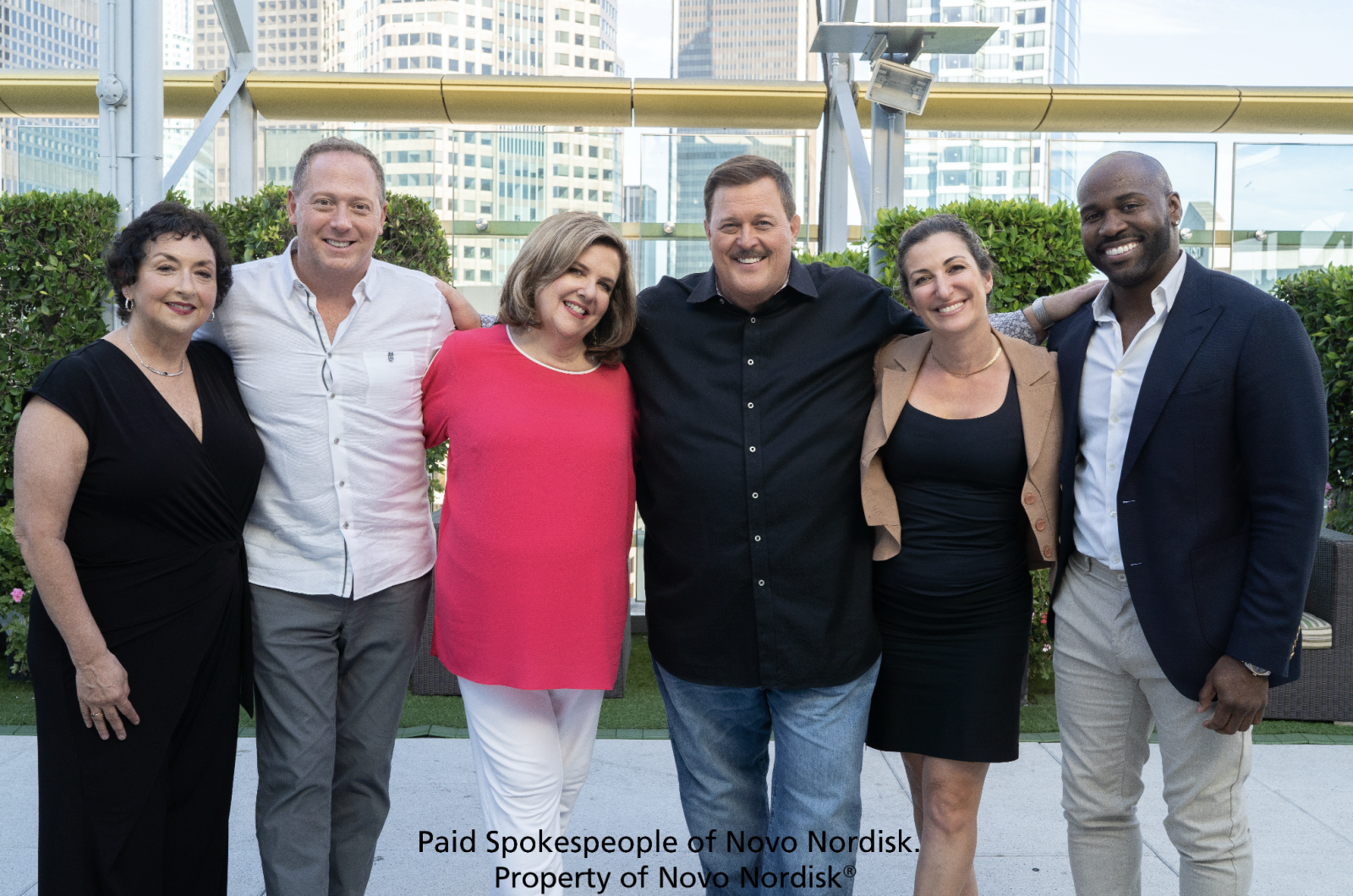My Type 2 Diabetes Transformation: A Conversation with Billy Gardell
By Eliza Skoler
 By Cherise Shockley and Eliza Skoler
By Cherise Shockley and Eliza Skoler
Comedian and actor Billy Gardell spoke with diaTribe about his journey with type 2 diabetes and how he has changed both his outlook and his habits
Novo Nordisk recently launched a video series and health program for people with type 2 diabetes. My Type 2 Transformation shares celebrity Billy Gardell’s personal journey with type 2 diabetes, as he goes through a program that combines Ozempic (a once-weekly GLP-1 agonist) with meal-planning, exercise, and life-coaching to improve health. The videos are available for free on the site, along with resources on nutrition, exercise, and wellness.
diaTribe’s community manager, Cherise Shockley, spoke with actor and comedian Billy Gardell about his journey with type 2 diabetes. They were joined by Dolvett Quince, the program’s athletic trainer, and Laleh Mohajerani, the program’s diabetes educator.
Cherise: When were you diagnosed with type 2 diabetes?
Billy: I was diagnosed about a year and a half ago, and like a lot of people who have type 2, I did not realize how long I had been walking around with it. I was lucky that during a regular physical my doctor decided to do a full battery of blood tests -- that’s when my A1C came back at 7.2%, and we realized that I had type 2 diabetes and had to get into action.
Cherise: So when your doctor diagnosed you, what was your first reaction?
Billy: It’s scary when you hear those words come out of your doctor’s mouth. My dad had type 2 diabetes. My first reaction was shock, and then you kind of want to ignore it and pretend it’s not there. But the only way to overcome something is to face it. So that’s what I’ve been trying to do with this – the My Type 2 Transformation team has put together a program where you really can’t go wrong if you just follow it. There’s an exercise plan that’s specific to type 2 diabetes; there’s a life coach to motivate a mental shift; there are recipes and meal planning tips; and there’s information about Ozempic. With all those things working in conjunction, you’ve got a real chance to manage your diabetes.
Cherise: How has Ozempic and the My Type 2 Transformation program affected your diabetes treatment? And why did you join My Type 2 Transformation?
Billy: Well along with the Ozempic, the exercise, the meal-planning, and talking to our life coach, I’ve had a lot of changes. I’ve had a change in my relationship with food: understanding that pizza is not a reward, it’s a punishment – and I don’t think I ever would have thought of that in my life. I’m also learning that the more I care for myself, the better I feel, and that’s a big deal for me. It’s nice to not be feeling lethargic anymore. It’s nice to not be feeling like I have to fall asleep at 4 p.m. in the afternoon. It’s nice to not eat a meal and then crash immediately after. It’s nice to not have blurry vision. Those things many people just chalk up to ‘oh I’m just tired,’ but no, I’m not. I have type 2 diabetes, and I need to be aware of that. And once you’ve got all that crap out of your system – and I still have a long way to go, and I don’t do it perfectly – I feel so much better since I started this program.
My Type 2 Transformation has changed my life for the better, and if that can be an example for someone else, then I’m all for it. I joined the My Type 2 Transformation program because I wanted to hold myself accountable to improving my health – which, I admit, is a little selfish – if you’re going to put yourself all over the internet with your name on it, you’d better be walking the walk! That, and Dolvett -- he sort of forces me to stay in line.
Cherise: I was going to say! Dolvett seems like an excellent and motivating trainer. So what are the greatest obstacles you see towards exercising for people with type 2 diabetes, and what do you suggest so that people can get started with small steps?
Billy: The beauty of D-Fit – the exercise program – is that there is a level for everyone. You don’t have to be an athlete, and you don’t have to be in great shape to just start. The training can be really hard, but Dolvett works according to where you’re at, and you must work.
 Dolvett: Diabetes doesn’t mean defeated. It doesn’t mean I have a body I can’t use or take care of myself. With that in mind we made the fitness program a three-stage workout (beginner, intermediate, advanced), and wherever you are in your regime, you can come into it knowing that there is a place for you.
Dolvett: Diabetes doesn’t mean defeated. It doesn’t mean I have a body I can’t use or take care of myself. With that in mind we made the fitness program a three-stage workout (beginner, intermediate, advanced), and wherever you are in your regime, you can come into it knowing that there is a place for you.
I believe everyone can get in shape and make exercise a part of their life. The program is designed to do just that – get you moving and motivated to start an exercise routine. It includes basic, simple exercises you can do to wake up your heart rate, improve range of motion, and build core muscle strength. I’ve created workout videos showing the full body exercises for each level (beginner, intermediate, and advanced), as well as tips for exercising inside or outside of your home. And the best part? The entire D-Fit exercise series is available to everyone for free on the My Type 2 Transformation site.
Cherise: As a person with diabetes it is so powerful to hear that there is something for everyone, no matter where you are in your journey, that once you get up and start doing something this could actually help. What is your fondest wish in diabetes for people living with diabetes?
Billy: My wish is that people don’t avoid it and that they seek help to manage it. I’m hoping I can annoy my wife for at least another 25 years, and I’d like to be here to watch my son grow up. My hope is that someone sees this and says, “You know what, if he can do it, I can do it.”
Dolvett: I think that’s a great hope. Just to echo that, don’t wait until things get so bad to start taking care of yourself. A lot of diabetes issues are preventable and manageable, and that’s exactly what this aims to help with. I’m so proud of this program, and I’m excited to help people.
Cherise: What recommendations do you have for people to help manage their diabetes, with or without Ozempic treatment?
Laleh: Our hope is that people will look at this program as a good example of how the three elements (nutrition, exercise, and medicine) can fit together to make it possible for people to manage their diabetes. Through watching the videos, people will learn meal-planning, exercise tips, and wellness strategies, and they will learn about Ozempic. Ozempic is a non-insulin, once-weekly, injectable medicine that is used in conjunction with exercise and diet changes to lower blood sugar.
Cherise: Billy, when did you start using Ozempic? And do you use a continuous glucose monitor (CGM) to measure your blood glucose?
Billy: I’m at about 10 or 11 months on Ozempic now, and I don’t have a CGM. I use a blood glucose meter every day, to check and make sure that I’m staying in my target blood sugar range. It’s a great mapping system, along with everything else I’m doing. Like the other day: I had a banana that shot my numbers up, and I didn’t realize that a banana could do that. So that goes on the list of “okay, we’ll stay away from bananas.” So I check my blood glucose to keep mapping what I can eat and what I shouldn’t eat.
Cherise: That’s funny, bananas are a problem food for me, as well.
Billy: Bananas and white rice send my blood sugar through the roof, so I just stay away from them.
Cherise: So you’ve learned a lot about diabetes management. And from one person with diabetes to another, there is no perfect. We just get up, try our best, and take it one day at a time. What you are doing is amazing because there is a lot of stigma surrounding diabetes, so we love to see people like you sharing their stories with other people who may not be so vocal. So thank you for using your platform to help other people with type 2 diabetes.
Billy: And look, life happens, and you’re going to make mistakes with diabetes. And one of the biggest things I’ve learned is don’t make a mistake last three weeks – make a mistake and then get right back on the horse. Surround yourself with people who have good information and try, just keep trying.
Billy is a paid spokesperson for Novo Nordisk and was compensated for his participation in My Type 2 Transformation. He used his insurance plan to get access to Ozempic, as prescribed by his doctor.
To learn more about Ozempic, see the Prescribing Information and Medication Guide at Ozempic.com.








